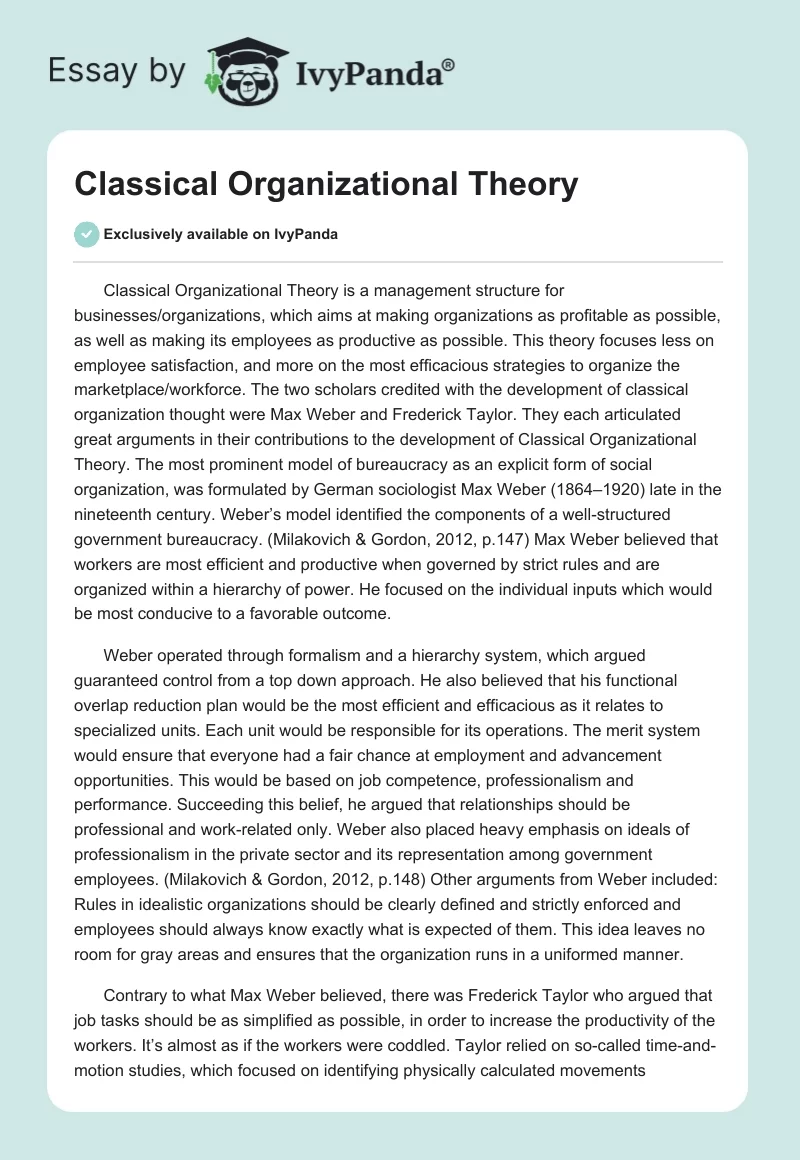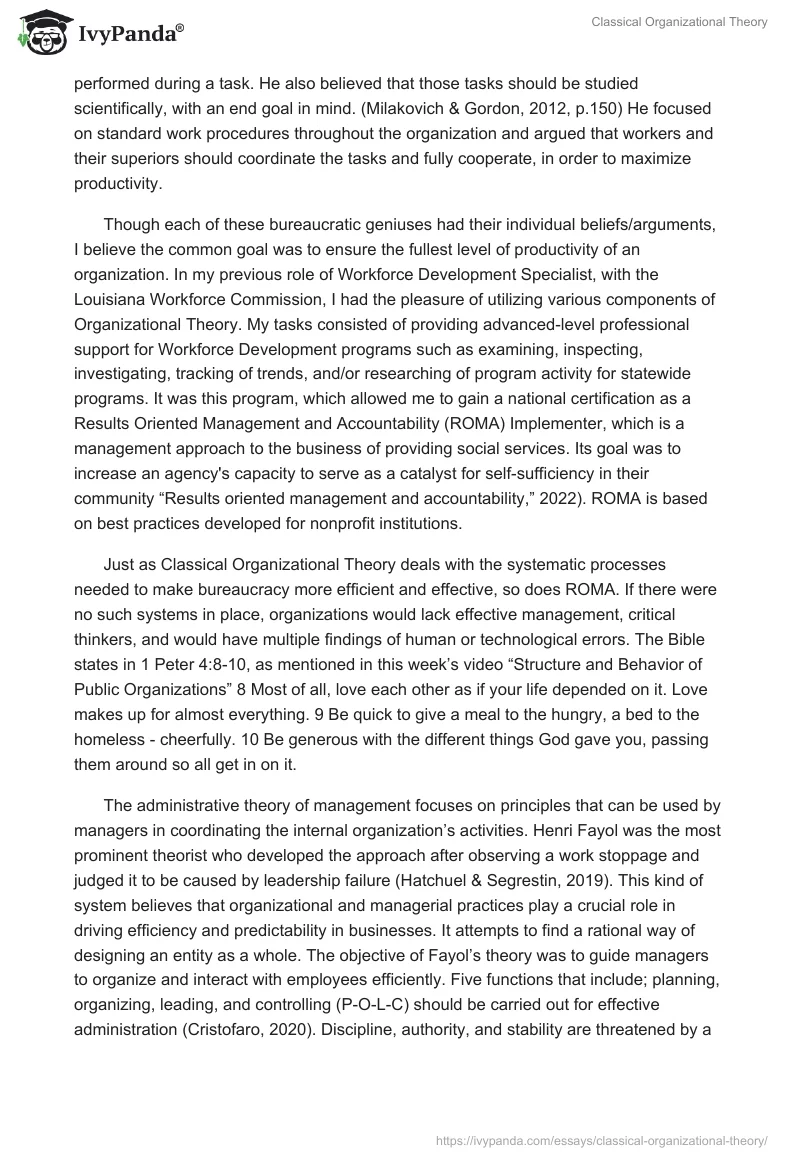Classical Organizational Theory is a management structure for businesses/organizations, which aims at making organizations as profitable as possible, as well as making its employees as productive as possible. This theory focuses less on employee satisfaction, and more on the most efficacious strategies to organize the marketplace/workforce. The two scholars credited with the development of classical organization thought were Max Weber and Frederick Taylor. They each articulated great arguments in their contributions to the development of Classical Organizational Theory. The most prominent model of bureaucracy as an explicit form of social organization, was formulated by German sociologist Max Weber (1864–1920) late in the nineteenth century. Weber’s model identified the components of a well-structured government bureaucracy. (Milakovich & Gordon, 2012, p.147) Max Weber believed that workers are most efficient and productive when governed by strict rules and are organized within a hierarchy of power. He focused on the individual inputs which would be most conducive to a favorable outcome.
Weber operated through formalism and a hierarchy system, which argued guaranteed control from a top down approach. He also believed that his functional overlap reduction plan would be the most efficient and efficacious as it relates to specialized units. Each unit would be responsible for its operations. The merit system would ensure that everyone had a fair chance at employment and advancement opportunities. This would be based on job competence, professionalism and performance. Succeeding this belief, he argued that relationships should be professional and work-related only. Weber also placed heavy emphasis on ideals of professionalism in the private sector and its representation among government employees. (Milakovich & Gordon, 2012, p.148) Other arguments from Weber included: Rules in idealistic organizations should be clearly defined and strictly enforced and employees should always know exactly what is expected of them. This idea leaves no room for gray areas and ensures that the organization runs in a uniformed manner.
Contrary to what Max Weber believed, there was Frederick Taylor who argued that job tasks should be as simplified as possible, in order to increase the productivity of the workers. It’s almost as if the workers were coddled. Taylor relied on so-called time-and-motion studies, which focused on identifying physically calculated movements performed during a task. He also believed that those tasks should be studied scientifically, with an end goal in mind. (Milakovich & Gordon, 2012, p.150) He focused on standard work procedures throughout the organization and argued that workers and their superiors should coordinate the tasks and fully cooperate, in order to maximize productivity.
Though each of these bureaucratic geniuses had their individual beliefs/arguments, I believe the common goal was to ensure the fullest level of productivity of an organization. In my previous role of Workforce Development Specialist, with the Louisiana Workforce Commission, I had the pleasure of utilizing various components of Organizational Theory. My tasks consisted of providing advanced-level professional support for Workforce Development programs such as examining, inspecting, investigating, tracking of trends, and/or researching of program activity for statewide programs. It was this program, which allowed me to gain a national certification as a Results Oriented Management and Accountability (ROMA) Implementer, which is a management approach to the business of providing social services. Its goal was to increase an agency’s capacity to serve as a catalyst for self-sufficiency in their community “Results oriented management and accountability,” 2022). ROMA is based on best practices developed for nonprofit institutions.
Just as Classical Organizational Theory deals with the systematic processes needed to make bureaucracy more efficient and effective, so does ROMA. If there were no such systems in place, organizations would lack effective management, critical thinkers, and would have multiple findings of human or technological errors. The Bible states in 1 Peter 4:8-10, as mentioned in this week’s video “Structure and Behavior of Public Organizations” 8 Most of all, love each other as if your life depended on it. Love makes up for almost everything. 9 Be quick to give a meal to the hungry, a bed to the homeless – cheerfully. 10 Be generous with the different things God gave you, passing them around so all get in on it.
The administrative theory of management focuses on principles that can be used by managers in coordinating the internal organization’s activities. Henri Fayol was the most prominent theorist who developed the approach after observing a work stoppage and judged it to be caused by leadership failure (Hatchuel & Segrestin, 2019). This kind of system believes that organizational and managerial practices play a crucial role in driving efficiency and predictability in businesses. It attempts to find a rational way of designing an entity as a whole. The objective of Fayol’s theory was to guide managers to organize and interact with employees efficiently. Five functions that include; planning, organizing, leading, and controlling (P-O-L-C) should be carried out for effective administration (Cristofaro, 2020). Discipline, authority, and stability are threatened by a lack of oneness. The theory calls for a clear division of labor, administrative structure, and delegation of power by the administrators to their relevant areas of responsibilities.
The administrative theory believed that with proper approaches by managers and scientific forecasting, predictable results could be followed to yield satisfaction in an organization. Fayol further identified principles of management that include the remuneration of employees, centralization of the decision-making processes, and equity which states that all workers should be treated fairly (Hatchuel & Segrestin, 2019). A clearly defined scalar chain is also recognized as crucial since it defines the position of each individual in a business. The workplace facilities should be kept clean, tidy, and safe for improved performance. The table 1 below shows the points of the three authors that contributed to the development of the classical organizational theory.
Table 1: The Three Modules of Classical Organization Theory
To conclude, I believe the message here is that as Christians, we should all strive to live as Jesus did, love as he did and easily forgive. We all make mistakes and are not infallible. However, just as in making mistakes in business or the workforce, we must take those mistakes as learning opportunities. We must build from those moments, with the aim to improve going forward.
References
Cristofaro, M. (2020). “I feel and think, therefore I am”: An Affect-Cognitive Theory of management decisions. European Management Journal, 38(2), 344-355. Web.
Hatchuel, A., & Segrestin, B. (2019). A century old and still visionary: Fayol’s innovative theory of management. European Management Review, 16(2), 399-412. Web.
Milakovich, M. E., & Gordon, G. J. (2012). Public Administration in America (11th ed.). Cengage Learning US. Web.
Results oriented management and accountability (ROMA) national peer to peer training project (NPTP). (2022). ROMA-NPTP. Web.


